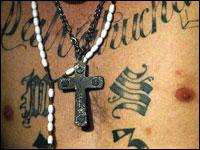Transcript
BOB GARFIELD:
If you're a politician seeking to demonize illegal immigrants, there's nothing to make you feel righteous quite like MS-13. The Salvadoran gang, also known as Mara Salvatrucha, has grown from its Los Angeles roots in the '70s to infiltrate and terrify a growing number of U.S. communities, where heavily tattooed gang-bangers have engaged in crimes as petty as vandalism and as gruesome as machete dismemberments and murder.
The largest part of the terror, however, has lived in the headlines as the press fixates on the Latin menace. One documentary on the National Geographic Channel called MS-13 "the world's most dangerous gang." But gang population estimates suggest otherwise, and so does the testimony of many law enforcement officials.
Kevin Pranis of the Justice Policy Institute has just coauthored a report titled Gang Wars, and he joins me now. Kevin, welcome to On the Media.
KEVIN PRANIS:
Thanks for having me here.
BOB GARFIELD:
Before we get started, you're not suggesting that a fast-growing gang with violent tendencies is of no concern, are you?
KEVIN PRANIS:
I think that any violent activity that's happening should be of concern, whether it's by gang members or other youth. And so, obviously, when killings are happening, when stabbings are happening, that's a huge concern for the victims and families and communities that are involved.
BOB GARFIELD:
But the idea of an MS-13 menace threatening all of us, even those of us, you know, hitherto feeling safe in the suburbs, is a bit overblown. Why?
KEVIN PRANIS:
In all of our work, we were unable to find any evidence that MS-13 was significantly different from any other street gang. In Los Angeles, MS-13 is just another gang. We asked whether - they said, yeah, they're a gang. They're a problem for us, just like 18th Street, plenty of other gangs. But they didn't see anything special in MS-13. It's really only out here in the East Coast, the Southeast, the people seem to be so terrified of MS-13.
BOB GARFIELD:
You say that MS-13 is more of a brand than an organization. Are young men and boys attracted to it for the same reason they're attracted to, I don't know, Tommy Hilfiger?
KEVIN PRANIS:
Absolutely, and I think that law enforcement politicians and the media have really been the most effective at proliferating the MS-13 brand. And it's a combination, in fact, of our immigration policy, the deportation of many people from Los Angeles who are part of MS-13 to El Salvador, that provided real fodder for gang growth, and then the TV coverage of the gang, the sort of hype that surrounds it, that's really made it the most exciting gang to be a part of.
And I think that it's been publicized much too much. I talked to someone who'd gone to El Salvador and met a bunch of MS-13 members who'd basically recruited themselves from media coverage. They had never actually met a made MS-13 member before.
BOB GARFIELD:
So what is it about MS-13 that has so captured the imagination of the press?
KEVIN PRANIS:
I think it's the fact that the suburbs are no longer lily-white. There's a huge influx of immigrants into communities that had previously been all white or, in the Southeast, white and black, and that's caused a great deal of fear.
So activities that were probably going on among, say, white and black youth for many years in the Southeast are now attracting considerable attention because they're being done by strangers, outsiders who speak a strange language.
And, in fact, Latino and gang have become almost synonymous, although when I was growing up it was Crips and Bloods and you rarely heard about Latino gangs. Now, apparently, all gang members are Latino.
There are other aspects, though, of MS-13 that I think captured the imagination. They have characteristics like the use of machetes, which, while I'd consider a machete a far less lethal weapon than a gun, the coverage has suggested that somehow machetes are an even more savage sort of weapon than any weapon previously conceived and that machete-wielding gangsters should cause more fear than 15-year-olds with machine guns.
BOB GARFIELD:
The fear of MS-13 has recently taken on some important political implications as various politicians have come into Newark, New Jersey, to decry the murders of three young students there by perpetrators allegedly including two illegal immigrants, who may or may not have had gang connections, and have not only [LAUGHS] connected them to MS-13 but to Muslim terrorists and God knows who all.
Does MS-13, in fact, stand for the political demonization of Latino immigrants, in general?
KEVIN PRANIS:
Absolutely, and that's why the murder of - which was a gruesome murder - of Brenda Paz near Washington, D.C., is so important, because it happened so close to the Capitol. I think that was either MS-13's greatest success or greatest mistake, depending on whether you want the gang to grow.
They got the attention of federal lawmakers. That got the attention of the national media. And so MS-13 has become the poster child for the dangers of immigration, if you listen to the anti-immigrant advocates, or people who need to be separated away from the good immigrants.
And the reality of gangs, as we found out, is there's all sorts of youth that get involved in gangs who have the possibility of going past it, right - that gang membership is not a lifelong thing. It's actually generally quite a transitory thing.
But unfortunately our obsession with MS-13 as the peril from south of the border, coming wielding machetes and with their, you know, incredibly tight-knit political and criminal organization is really unfortunately distorting the debate.
BOB GARFIELD:
Kevin, thank you very much.
KEVIN PRANIS:
Thank you.
BOB GARFIELD:
Kevin Pranis of the Justice Policy Institute is coauthor of the report titled Gang Wars.
[MUSIC UP AND UNDER]

